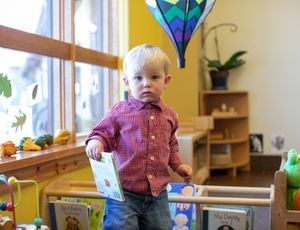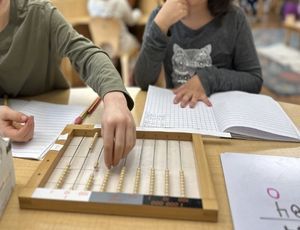When we hear the word “discipline,” we usually connect it with children’s behavior. It can be at home, school, a park, or any other setting, and it will take us to the question, “how do we get our children to behave?” Our understanding of freedom and discipline will affect our observations, our interpretations, and our daily interactions with our children. In this month’s article, we will discuss the meaning of freedom, limits, and discipline. We will look into the positive ways to set limits without hindering freedom and independence.
Many of us grew up with the belief that behaving means to do what the adult says, and the expectation placed on a well-behaved child was to listen patiently and follow directions without complaining. If we did not do it, the discipline was necessary. If a change is to be made in the way we see the child, we must reflect on what discipline means and our role as parents of young children.
Discipline does not mean immobility and silence. Discipline means independence, ability to make choices, and understanding limits, but how can a child make choices if he is required to follow directions? Our attitude toward freedom and discipline needs to change. The fast strategy often used to make children follow instructions are rewards and punishments. They can be used by well-meaning adults trying to motivate their child, but this popular method of controlling behavior won’t have a long term positive impact. Yes, the child might agree to do something because he is afraid of the negative consequences, but it won’t be because he is motivated to do it. Punishments like not watching TV, not playing with a specific toy, or not having dessert are negative, as is bribing them, giving them stickers or any other reward if they do something the adult wants. The child has no freedom of thinking and making choices in these situations; we are placing all the responsibility on us, and it can be exhausting. There is no independence being developed, and we will continuously be thinking about what we have to do now to get our children to do what we want.
What is freedom?
Most people think that freedom is the opposite of discipline because apparently, you get to do whatever you want. However, in a Montessori environment, freedom is recognized as a positive aspect that every child should be able to develop. Most importantly, we realize that freedom and discipline are not external forces that are administered to the children.
Freedom is the ability to pause and make a specific choice that is independent of any external coercion; it is an internal state and comes from within.
What is discipline?
Since it is not imposed externally, in Montessori we see discipline as self-discipline. The adult does not require the child to be obedient and immobile; in fact, we believe discipline comes when the child is active. It is tightly connected with development of movement. The child is not born with already mastered motor skills, but has the potential to develop them. The same happens with self-discipline; the child is born with the potential to develop it if we support it.
Rather than being opposites, discipline and freedom are very much alike. They both are internal processes and they are both related to making choices.
How do we set limits?
Limits are essential to help children develop their ability to make choices; they are necessary for freedom. We offer a limited number of activities or options that the child will succeed with. Will you eat the apple slices or the carrot sticks? Are you going to pick up the blocks first or the doll? Are you going to wear the yellow shirt or the green one? We narrow the options so children can develop their independence in making choices. They feel they are in control of the situation and you are still putting limits on them by selecting only positive options for them to choose.
As children become older and they have practiced their ability to make choices, you can add more options. The limits expand, but they are still there.
Consequences
These are always present after making a choice. They are necessary because it gives feedback to the child about what he just decided to do. The next time, he will recall the consequences and will make a choice based on his experience, not on what the adult says. If a child decides to carry all the toys at the same time and he falls because of the overload, the adult can offer him objective feedback about what happened, and next time, he might decide to carry fewer objects to avoid falling.
Feedback
Feedback is essential if we are to avoid bribes and threats. The information we give to our children about what happened will be processed internally and help them make better decisions in the future. If there is no feedback, they might not understand what happened and why, so they might do it again. Talk to your child about what happens, and do it in a very objective way. “Since your snack is now on the floor, the plate is empty and you won’t be able to eat it. Tomorrow we can try again.” Feedback reinforces the limit you set with respect and patience, offering the child the opportunity to process the information one more time. The way you give feedback must be consistent, the limit you set also has to be consistent and there cannot be any shaming aspect while talking about the consequences. Remember, it is an internal process to develop self-disciple; it is not something the adult can impose on children when they want to.
Quick-fixes to avoid
- Time outs (emotional punishment)
- Any physical consequence (punishment)
- Any shaming “Your brother can do it very well; why can’t you just do it?” (emotional punishment)
- Planting fear “I am going to tell your dad”or “I will tell the police I have a badly behaved son” (threat)
- Rewarding “If you do this, I will give you that” (bribing)
Instead, try
- Problem-solving together with your child
- Respectful feedback about what happened
- Managing your expectations and understanding the abilities of your child
- Offer clear choices
- Give your child time and space to make a choice
- Offer help and cooperate with him
Quote of the Month
“The fact is that kids learn to make good decisions by making decisions, not by following directions.”
-Alfie Kohn
Item of the Month
Melissa and Doug Cleaning Set
This set of tools will give your child multiple options to take care of his environment. He can swipe, mop, dust, or even use the hand brush to clean crumbs from the table and floor. Make sure you show him how to do it first and then let him take it from there. Don't be surprised if you catch him putting water on the floor so that he can mop.
Link to buy it at Amazon:
https://www.amazon.com/-/es/Kids-Cleaning-Set-Piece-Housekeeping/dp/B07V4RX9TM/ref=sr_1_2?dchild=1&keywords=doug%20and%20melissa%20cleaning%20set&language=en_US&qid=1594755166&sr=8-2
Have a little extra time?
Setting limits with Respect by The Montessori Show
Enjoy this one-hour conversation with two seasoned Montessorians and parent educators, where they discuss how to support children setting limits with respect in efficient ways. They will answer many popular parent’s questions that you might find interesting as well! Enjoy!
YouTube link:
https://youtu.be/p5pUalT1vIs



